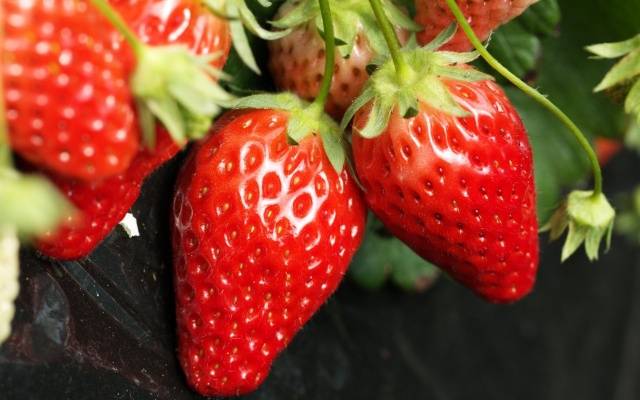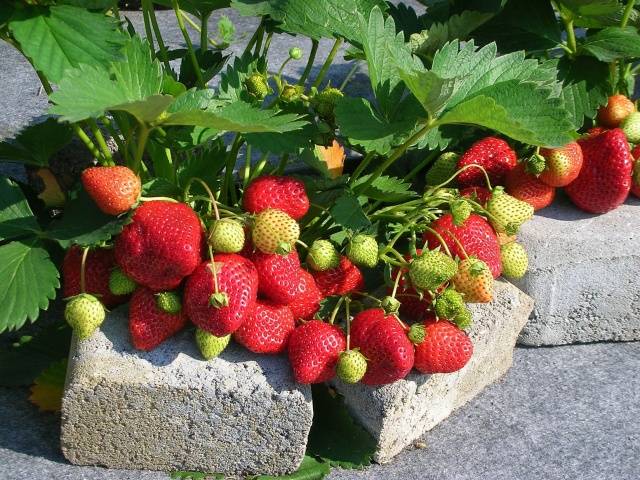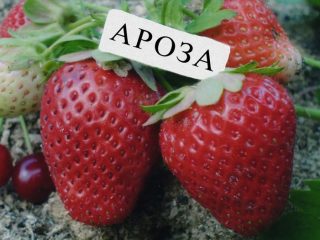Content
The weather conditions of the Urals dictate the conditions for growing strawberries. To harvest a good harvest of berries, you need to choose varieties that meet the following conditions:
- ripen in a short time;
- do not freeze out in winter;
- withstand heavy rains;
- do not rot in summer.
An area well lit by the sun is suitable for planting strawberries. In the Urals, dew often falls and there is increased fog, so the strawberry plant should be well ventilated.
Strawberry prefers medium loam to which organic fertilizer is applied. Plants tolerate Ural frosts well because they are under high snow cover.
The greatest risk of freezing occurs in autumn or spring. During this period, the strawberry plant needs additional shelter.
Early varieties
The earliest strawberry varieties for the Urals they begin to bear fruit in June. Strawberries of this type develop in short daylight hours and tolerate spring cold snaps and lack of heat well.
Maria
The Maria variety is characterized by very early ripening. Strawberries look like a medium-sized bush with a lot of leaves.The weight of the fruits is on average 30 g, they stand out with a rich color. A moderate amount of whiskers is formed.
Maria is characterized by increased winter hardiness. The plant remains resistant to spring frosts and is little susceptible to disease.
Amulet
Strawberry Amulet is a dessert variety. The berries weigh about 35 g, have an elongated shape and a rich color. The plant stands out for its good yield and winter hardiness. Up to 2 kg of fruits are collected from one bush.
The plant requires regular watering, especially in the absence of rain. The variety is little susceptible to diseases and is rarely affected by the strawberry mite.
Valenta
The Valenta variety is a medium-sized bush, moderately spreading. The peduncles are of medium length, the leaves are few and wide.
Valenta fruits have an average weight of 15 g, the largest reach 30 g. The shape of the fruit is oblong conical, they taste sweet and sour.
Valensa is resistant to diseases and does not rot even in high humidity.
Zarya
Zarya is one of the most popular varieties of strawberries in garden plots. Its bushes grow tall, however, the berries are produced weighing about 20 g. The leaves are large, dark green in color.
The variety is considered early ripening and high-yielding. Up to 200 kg of fruits are harvested from one hundred square meters of plantings.
The shape of the fruit is smooth oval, with a short neck. The pulp is light and has medium density.
Zarya requires moderate watering and fertilizing with mineral fertilizers. The plant demonstrates resistance to fungal infections. Zarya can withstand even severe winter frosts.
Medium-ripening varieties
The best varieties of strawberries mid-ripening varieties are distinguished by their taste. This is due to the fact that fruit formation occurs after warm weather sets in.
Elsanta
Variety Elsanta bred in Holland and valued for its dessert properties. The plant is characterized by mid-early ripening and long fruiting.
Elsanta is considered a universal type of garden strawberry, which is used fresh, frozen and canned.
Elsanta fruits are quite large, weighing about 50 g. The pulp is sweet and aromatic, with a slight sourness.
Strawberries have average resistance to drought, however, they can withstand severe frosts. Additionally, the bush is treated against powdery mildew and rhizome lesions. Fungal diseases rarely affect these strawberries.
Sudarushka
Sudarushka refers to medium ripening varieties. The plant stands out as a powerful, spreading bush, with a large number of leaves and rosettes. Peduncles are located along with the leaves.
The weight of Sudarushka berries is up to 34 g, their shape is symmetrical oval. The pulp is medium dense, juicy, tastes sweet and sour. Strawberries show high productivity.
The Sudarushka variety is resistant to fungal infections; strawberry mites are rarely found on it.
For planting, choose an open area well lit by the sun. The plant prefers black soil with the addition of peat. It is recommended to mulch strawberries with straw.
Festival daisy
Variety Festival Chamomile bears fruits weighing about 40 g during the first harvest. Then the berries become smaller.
The bush is formed large, with a large number of leaves. During the season, strawberries produce many tendrils.Festivalnaya is a medium-ripening variety and bears fruit in mid-June.
The berries of Festival Chamomile are oval in shape and slightly flattened at the edges. They taste sweet and sour.
The plant has increased resistance to winter frosts and tolerates frosts of -25°C. Festival chamomile is considered an unpretentious variety, so it is often grown in the Urals.
Orlets
The Orlets strawberry was bred in the Sverdlovsk region and has a long ripening period. The variety is distinguished by its increased resistance to diseases and tolerates winter frosts.
Orlets is considered a dessert variety and produces a good harvest. More than 110 kg of fruits are collected from one hundred square meters. The bush is medium-sized, moderately spreading, with a small number of leaves. Few tendrils are formed per season, so the plants require minimal care.
The berries have an average weight of 10 g and an elongated shape. The weight of the first fruits reaches 25 g. Strawberries tolerate long-term transportation well. The eagle requires feeding and annual hilling.
Queen
Variety Queen bred specifically for harsh climates. Strawberries are frost and winter resistant. The queen is able to bear fruit in low light conditions.
The queen produces large berries, the average weight of which is 35 g. The pulp is juicy with a sweet and sour taste.
Under the snow cover, the Tsarina tolerates frosts down to -40°C. However, the variety copes well with hot weather. For full growth, strawberries require abundant watering.
The queen is resistant to diseases and pests. The fruits tolerate long-term transportation and storage.
Late varieties
Late-ripening strawberries have a rich flavor. Its varieties do not require special care and allow you to get a harvest after the end of the berry season.
Zenga Zengana
Strawberry Zenga Zengana grown in garden plots and on an industrial scale. The plant bears fruit even with short daylight hours. The berries weigh up to 30 g and have a dense skin.
Zenga Zengan bushes stand out for their height and large number of leaves. Quite a few whiskers are formed.
The largest berries ripen at the beginning of fruiting, then their size decreases. Zenga Zengana produces up to 1.5 kg of berries. The plant tolerates prolonged rains well.
The variety requires additional treatment against spotting, gray rot and strawberry mite. Strawberries are especially resistant to winter frosts; they are not afraid of frosts down to -24°C.
Roxana
Dessert variety Roxana bred by Italian specialists, however, it has taken root well in the conditions of the Urals. The plant has a medium-late ripening period.
The bushes are formed powerful, but at the same time compact, with a small number of mustaches. The berries are large and have good taste. Towards the end of the season, the size of the fruit decreases slightly. Even if the harvest is not picked on time, this will not affect the quality and taste of the berries.
Roxana is used for growing in autumn. The fruits ripen even at low temperatures and cloudy weather. The variety can withstand cold temperatures down to -20°C and is resistant to diseases.
Vikoda
One of the latest ripening varieties is Vikoda. The bushes are formed of medium height with thick shoots. The fruits are distinguished by their round shape, large size, sweet and sour taste, and dense pulp.
Vikoda ripens in mid-June. The bush produces a few shoots, which makes caring for strawberries easier. The plant is especially resistant to the spread of leaf spot.
Vikoda does not require special environmental conditions.The plant prefers an abundance of sunlight and moisture. In dry weather, increase the intensity of watering. The variety tolerates temperatures down to -16°C in winter.
Pandora
Strawberry Pandora bears fruit at the end of the berry season. The plant is compact and has a large number of leaves. The speed of whisker formation remains at an average level.
Pandora is a large-fruited variety, the weight of its berries ranges from 35 to 60 g. When finally ripe, they acquire a round shape, juiciness, sweet taste and aroma of wild strawberries.
Strawberries are distinguished by their high winter hardiness, so they do not require shelter. The plant has high immunity to damage to the root system and other diseases. To prevent fruit rotting in rainy weather, you need to mulch the soil.
Remontant varieties
Remontant strawberries bear fruit several times per season. Its flowering continues until the arrival of the first frost. During the season, 2-3 crops are harvested from each bush.
Temptation
Variety Temptation is early ripening and bears large berries. The plant is considered one of the most productive and is capable of producing 1.5 kg of fruit.
The taste of the berries is sweet, with an unusual nutmeg aroma. Up to 20 flower stalks are formed on the bush. Ripening begins 2 months after planting.
The harvest is harvested several times, and in the fall the taste of garden strawberries only improves. Temptation tends to form a large number of whiskers and therefore requires constant care.
The plant tolerates frosts down to -17°C, so it requires additional shelter. Plantings need to be renewed every 3 years.
Brighton
Brighton strawberries are considered a semi-remontant variety. If you plant the plant in the spring, you will receive the first harvest in August.
Strawberry bushes are compact, medium in size. Not many leaves are formed, which reduces the likelihood of rot and other diseases.
Brighton produces conical berries with a shiny surface. Their weight is about 30 g, the largest specimens reach 50 g. Brighton garden strawberries are characterized by a pineapple flavor. The pulp remains dense even after long-term storage.
The Brighton variety prefers loamy soils, remains resistant to diseases, and practically does not form runners during fruiting.
Lyubava
Lyubava is considered the best variety of remontant strawberries thanks to its unpretentiousness. The average weight of the berries is 30 g, however, they are produced on the plant in large quantities.
The shape of the Lyubava fruit is oval, the color is rich red. The main advantage of strawberries is its increased winter hardiness. Fruiting begins in June and continues until autumn. Throughout this period, the taste of Lyubava does not deteriorate.
The plant bears fruit abundantly regardless of the type of soil, however, it forms few tendrils. The variety is little susceptible to fungal diseases.
Geneva
Variety Geneva bred in America more than thirty years ago. This is a spreading bush of medium size, where about 7 tendrils are formed.
The first harvest produces fruits weighing up to 50 g in the shape of a truncated cone. The pulp has a sweet taste with a slight sourness. The plant begins to bear fruit in June and continues until frost.
There is a break of up to 2.5 weeks between each harvest period. Ripening occurs even in rainy weather.
A large distance is left between seedlings to avoid crowding of plantings.Otherwise, excess humidity and lack of ventilation will lead to the development of rot and other diseases.
Autumn Fun
Strawberry Autumn Zabava became one of the first remontant varieties obtained by domestic specialists. The plant is capable of bearing fruit from June to September. When covered under film in the fall, the berries continue to ripen until October.
The size of the fruits is from 3 to 4 cm, and many of them are formed. They taste sweet, even if they are not fully ripe. Fruiting occurs almost without interruption.
Autumn Zabava produces up to 20 flower stalks, each of which bears 10 fruits. The bush is rarely affected by diseases and pests. For the winter, strawberries require shelter.
Elizabeth the Second
Variety Elizabeth the Second notable for its unusual taste and large berries. The average fruit weight is 40 g, however, individual berries reach 100 g.
Strawberries were bred by Russian specialists and have become widespread since 2003. The plant forms tall bushes with abundant foliage. The berries have an unusual taste with notes of honey.
During the season, Elizabeth II produces about three harvests. The first of them is filmed in early June. The last fruiting occurs before the onset of frost. Due to the high yield, up to 1.5 kg of fruit is obtained from one bush.
Elizabeth the Second copes well with many diseases, withstands cold snaps in the spring and winter frosts.
Conclusion
For cultivation in the Urals, winter-hardy strawberries are chosen, which are not afraid of low temperatures. Strawberries must remain resistant to spring frosts, and the berries must ripen in a short summer and retain their taste even with heavy rainfall.
























where to order